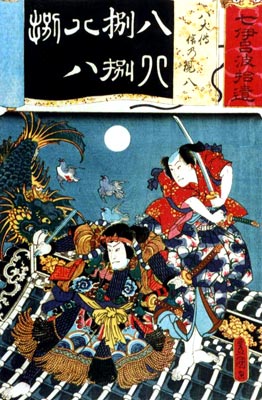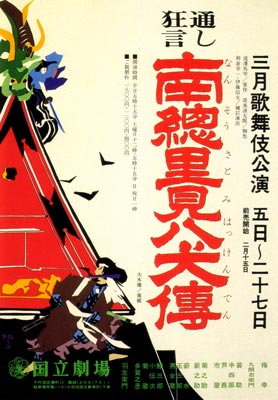| NANSď SATOMI HAKKENDEN |
| Play title | Nans˘ Satomi Hakkenden Hana no Ani Tsubomi no Yatsufusa Hakkenden Uwasa no Takadono Satomi Hakkenden |
| Authors | Takizawa Bakin (original novel) Nishizawa Ipp˘ ("Hana no Ani Tsubomi no Yatsufusa") Takarada Jusuke, Mimasuya Shir˘ ("Hakkenden Uwasa no Takadono") Atsumi Seitar˘ (1947 script) |
| History |
"Nans˘ Satomi Hakkenden" was originally a voluminous novel by the writer Takizawa Bakin (1767~1848), who worked from 1814 for 28 years to complete it. It was adapted for the first time to Kabuki in 1834 and staged in October in ďsaka at the Wakadayű no Shibai under the title "Kinkazan Yuki no Akebono". Nishizawa Ipp˘ wrote his own script, which was entitled "Hana no Ani Tsubomi no Yatsufusa" and was staged in the 1st lunar month of 1836 at the Naka no Shibai [casting]. The first satomi-hakkendenmono staged in Edo was "Hakkenden Uwasa no Takadono", written by Takarada Jusuke and Mimasuya Shir˘ and staged in the 4th lunar month of 1836 at the Moritaza [casting]. The first Bunraku adaptation was created a few month later, written by Yamada-no-Kakashi and staged in ďsaka in the 7th lunar month of 1836. Several others versions were written in Kamigata or in Edo, including Sakurada Jisuke III's "Satomi Hakkenden" (the first drama to be titled like this) which was staged in the 1st lunar month of 1852 at the Ichimuraza [casting]. Satomi-hakkendenmono were extremely popular, not only during the Edo period, but also during the Meiji era, with the actor Ichikawa Danjűr˘ IX refining the key role of Inuyama D˘setsu Tadatomo. In the modern times, it is worthy to note that the title "Nans˘ Satomi Hakkenden" was used for the first time in a script written by ďmori Chisetsu and staged in March 1934 at the Meijiza. After World War II, Atsumi Seitar˘ wrote his own script, mixing elements from many of the previous versions of "Hakkenden". This script was successfully used by the Ky˘genza, a troupe of young actors, who staged it in September 1947 at the Imperial Theater [casting]. This script became the standard one to be used for a production of "Nans˘ Satomi Hakkenden". It was used for example for the three t˘shi ky˘gen production of "Nans˘ Satomi Hakkenden" at the National Theatre, in March 1969, March 1982 and April 1991. The star Ichikawa Ennosuke staged "Satomi Hakkenden" for the first time in April 1975 at the Meijiza, using Yamada's Bunraku script. He reworked the script several times, with Ishikawa K˘ji or Tobe Ginsaku, to obtain a visually-striking drama full of keren. To show how much he attached importance to "Hakkenden", he put this drama in his collection of masterpieces (Ennosuke Jűhachiban). |
| Structure |
The revivals at the National Theatre in March 1982 and April 1991 were made up of 6 acts (11 scenes) and 4 acts (10 scenes). In July 2002, Ichikawa Ennosuke staged a version made up of 1 prelude and 3 acts (11 scenes). Shorter productions are also possible (a few scenes gathered in 1 or 2 acts). |
| Key words |
Chűnori Ennosuke Jűhachiban Ennosuke Shijűhassen Fukkatsu T˘shi Ky˘gen Jűhachiban Jidaimono Keren Satomi-hakkendenmono |
| Summary |
The prologue shows the demise of Princess Fuse, the beautiful daughter of a 15th-century warlord who was slain by his wicked regent, Yamashita Sakuzaemon Sadakane. Princess Fuse had conceived during a mysterious union with her father's dog, Yatsufusa, and the resulting offspring are shown as eight green crystal balls issuing from her body. Each ball contains one Chinese character denoting a Confucian principle, such as JIN (benevolence) and GI (righteousness), and they disperse into the air; the spirits they embody will be born as human babies in eight different families. Sixteen years later Kanamari Daisuke Takanori, a former retainer of Princess Fuse's father and the slayer of the dog Yatsufusa, begins a search for the eight children, who all have the character inu (dog) in their surnames. The fantastic story of his quest unfolds in the succeeding scenes. Inuyama D˘setsu Tadatomo, leader of the eight Satomi heroes, is introduced first; he is shown praying to the tutelary goddess for the successful restoration of the Satomi family. The merciful deity gives D˘setsu a luminous ball bearing the character for CH█ (loyalty), and confers on him the ability to manipulate fire and water. Meanwhile, in the palace of Gov. Koga Nariuji, Inuzuka Shino Moritaka embodying Kď (filial piety) and Inukai Genpachi Nobumichi, who personifies SHIN (sincerity), fight against each other without knowing they belong to the same family. At the end of their fierce duel the brothers are reconciled through the good offices of Daisuke, now posing as a Buddhist mendicant called Chűdai. A scene set at Mount Maruzuka brings six of the siblings together. D˘setsu is performing a mystical rite -- inflicting burns on himself to induce a state of enlightenment -- when an elegant passerby, Inuzaka Keno Tanetomo, notices his crystal ball and approaches him. These two are then joined by four others: Shino and Genpachi posing as samurai, Inukawa S˘suke disguised as a servant, and Inue Shinbei dressed like a pageboy. There is an entertaining danmari (dumb show) as the six search for each other in the dark. As Act II opens, Genpachi, Keno and Shinbei are staying at an inn run by D˘setsu, while S˘suke is employed as his servant. Inuta Kobungo Yasuyori, the seventh of the Satomi heroes, is affiliated with the evil Sadakane, but when he drops by the inn he discovers his true identity, and pledges brotherhood with Genpachi and others. The warlord's former minister then arrives with the lord's grandson, Yoshiwakamaru, Princess Fuse's nephew, and entrusts him to the care of the Satomi brothers. Genpachi sets out on his search for the eighth hero, Inumura Kakutar˘ Masanori, who is found in the village of Tamagaeshi. The scene set in this village (Act II, Scene 2) is the highlight of "Hakkenden." This fantastical episode has at its center a vicious old cat that can transform itself into a human form. The cat slays Kakutar˘'s father, then assumes his likeness. Having learned that Kakutar˘'s attractive wife, Hinaginu, will give birth to a baby in the year of the rat, the monster is moved to murder. Having sent Kakutar˘ on an errand, the creature momentarily betrays its feline nature when it licks the fish oil poured into the lamp. Before Kakutar˘'s return, however, it murders Hinaginu. When Kakutar˘ discovers his wife's body -- and learns the truth of the cat's identity (and his father's death) -- he retaliates instantly with the assistance of Genpachi. The threesome clash in a fearsome midair fight that culminates with the appearance of a giant demonic cat on top of the devastated house, with the ferocious-looking cat/Ikkaku standing by it, glaring down at the warriors. More flying delights the audience in the following act, which ends with D˘setsu's escape from Sadakane's palace after failing to extort 30,000 ry˘ from the tyrant. Magically empowered, D˘setsu flies through the air, carrying on his back an enormous basket in which are hiding Keno and Yoshiwakamaru's mother. Source: Sasaguchi Rei |
 |
 |
|
The actors Band˘ Kamez˘ I (bottom/left) and Band˘ Hikosabur˘ V (right) performing the roles of Inukai Genpachi Nobumichi and Inuzuka Shino Moritaka in a print made by Utagawa Toyokuni III |
The poster of the t˘shi ky˘gen production of "Nans˘ Satomi Hakkenden", which was staged in March 1969 at the National Theatre |
|
|
| Contact | Main | Top | Updates | Actors | Plays | Playwrights | Programs | Links | FAQ | Glossary | Chronology | Illustrations | Prints | Characters | Derivatives | Theaters | Coming soon | News |